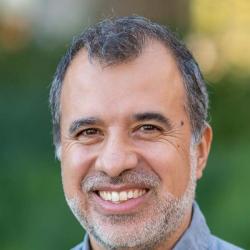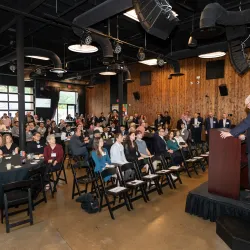Student Profile: Biophsyics Graduate Student Deborah Heminway
CMNS students have wide-ranging experiences and interests. Meet Deborah Hemingway, a fourth year gruaduate biophysics student, from Athens, Ohio.
Why did you decide to attend the University of Maryland?
I was drawn to the university because of its outstanding academic reputation and quality of the biophysics program.
What attracted you to your major?
I have always had a strong interest in the sciences, and while taking undergraduate physics courses, I felt myself especially drawn to homework problems related to biological systems which I would work even when not assigned. What solidified my interest in the biophysics program was my undergraduate research experience at the intersection of physics and biology.
What organizations are you involved with at UMD and why?
I currently serve as the president of the Graduate Student Government because I am passionate about advocating for students and care deeply about this university. I am also involved with Women in Physics, where I have made many lasting friendships and have been active in Fearless Founders. I have also volunteered for Physics is Phun and enjoy running the demos and explaining physics concepts. It is especially gratifying to reach out to children and youth in the community and encourage them to consider careers in the physical sciences.
Best memory so far as a Terp?
Passing my qualifying exam was a big relief and being sworn in as GSG president are tied of best memory. Both of those events made me realize how much I appreciate being here and what an incredible opportunity I have to do things that really matter and make a difference.
Favorite class so far and why?
My favorite class was Dr. Weeks’s chemical thermodynamics course. It was challenging, but Dr. Weeks is a wonderful professor, and I really enjoyed the material.
Favorite professor so far and why?
The University of Maryland has such outstanding faculty that it is impossible to pick only one. A few notable professors include Drs. John Weeks and Sergei Sukharev, for their excellence in the classroom; my advisors, Drs. Wolfgang Losert and Joe Redish, for their exceptional guidance; and Dr. Kimberly Stroka, for her extraordinary mentorship.
What advice would you give prospective students in your major?
It is challenging but rewarding. Work hard, do your best, and enjoy the journey.
What do you do in your free time?
I like to read academic journals, spend time with my family, and train for triathlons and half-marathons.
What do you want to do when you finish your degree?
My plan is to continue conducting research in an academic setting. But I also have an entrepreneurial itch. Maybe I can do both... we’ll see!
Has your time at Maryland influenced or changed your future plans?
Yes, I have been inspired by the work of many of our distinguished administrators, such as Provost Mary Ann Rankin. This interaction has influenced me to consider a career in an administrative role in an outstanding institution such as UMD one day and has inspired me to dream big.
Media Relations Contact: Matthew Wright, 301-405-9267, mewright@umd.edu
University of Maryland
College of Computer, Mathematical, and Natural Sciences
2300 Symons Hall
College Park, MD 20742
www.cmns.umd.edu
@UMDscience
About the College of Computer, Mathematical, and Natural Sciences
The College of Computer, Mathematical, and Natural Sciences at the University of Maryland educates more than 7,000 future scientific leaders in its undergraduate and graduate programs each year. The college's 10 departments and more than a dozen interdisciplinary research centers foster scientific discovery with annual sponsored research funding exceeding $150 million.







